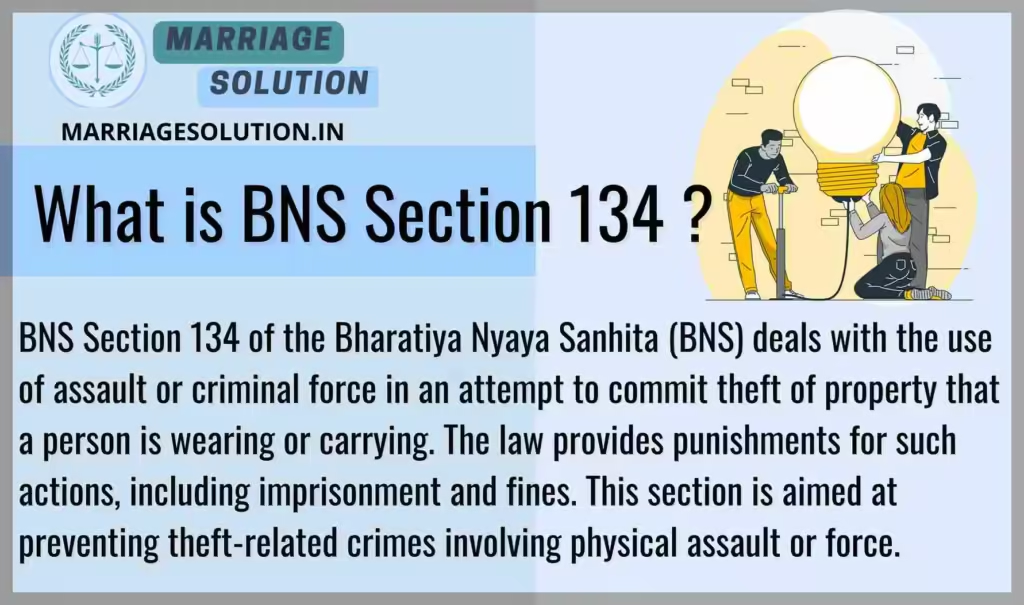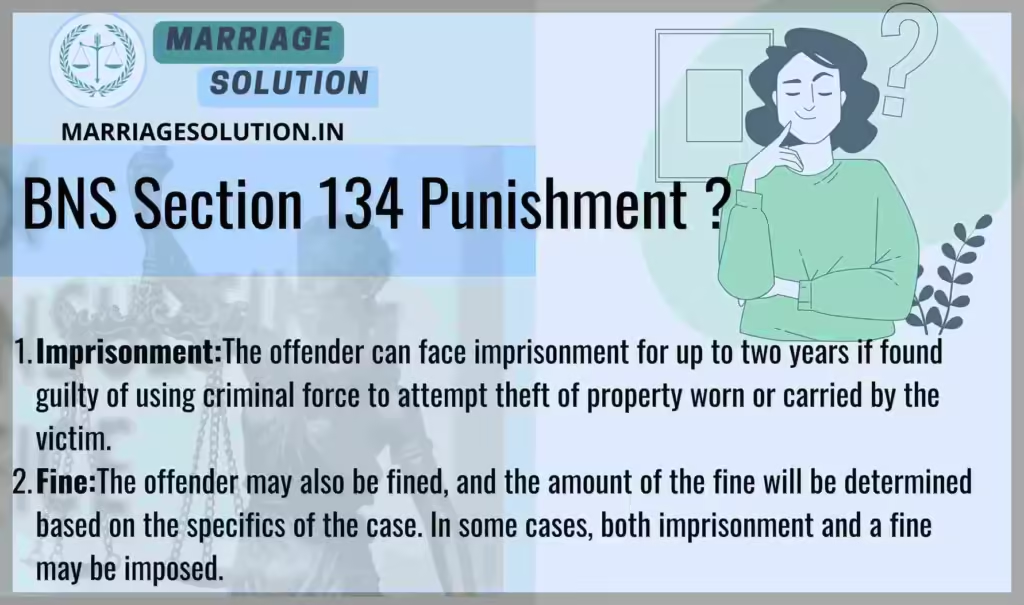Introduction of Section BNS 134
Bharatiya Nyaya Sanhita (BNS) Section 134 deals with situations where a person assaults or uses criminal force on another individual in an attempt to steal property that the person is carrying or wearing. It defines the punishment for such acts, including imprisonment and fines.
The Bharatiya Nyaya Sanhita (BNS) Section 134 replaces the old Indian Penal Code (IPC) Section 356.
What is section 134 of BNS ?
BNS Section 134 of the Bharatiya Nyaya Sanhita (BNS) deals with the use of assault or criminal force in an attempt to commit theft of property that a person is wearing or carrying. The law provides punishments for such actions, including imprisonment and fines. This section is aimed at preventing theft-related crimes involving physical assault or force.

Section 134 Bharatiya Nyaya Sanhita
“Whoever assaults or uses criminal force to any person, in attempting to commit theft of any property which that person is then wearing or carrying, shall be punished with imprisonment of either description for a term which may extend to two years, or with fine, or with both.”
This section is about snatching attempts—like bag-snatching, chain-snatching, or any theft attempt where force or assault is used on the victim.
- If someone attacks a person to steal property that is being worn or carried (like jewellery, handbags, or mobile phones), it is covered under Section 134.
- The offense is more serious than simple theft because it involves direct force on the victim’s body or belongings.
- Even if the theft attempt fails, the act of using force during the attempt is punishable.
- The punishment is up to 2 years imprisonment, or fine, or both.
Key Elements of Section 134
- Attempt to Commit Theft → Applies only when the property is on the victim’s body (clothes, bag, chain, phone, etc.).
- Use of Force or Assault → Must involve physical pushing, hitting, or threatening the victim.
- No Successful Theft Required → Even the attempt itself, if force is used, is enough for punishment.
- Punishment → Imprisonment up to 2 years, fine, or both.
- Cognizable → Police can arrest without a warrant.
- Bailable → Accused can get bail.
- Non-Compoundable → Cannot be settled privately; must go through court.
- Trial → Case is triable by any Magistrate.
Examples to Understand Section 134
Example 1 – Bag Snatching Attempt
Ravi pushes a woman while trying to grab her handbag. Even if he fails to take the bag, this act is punishable under Section 134 because he used force during theft attempt.
Example 2 – Chain Snatching
A thief pulls off a gold chain from Meera’s neck, causing a bruise. This is an assault with intent to steal property being worn.
Section 134 applies → Punishment up to 2 years or fine or both.
Why Section 134 is Important
- It protects individuals from physical assault linked with theft attempts.
- It covers snatching crimes that are common in public places.
- It punishes not only theft but also attempts with violence, ensuring personal safety.
- It sends a deterrent message that violence + theft will not be tolerated.
Section 134 BNS Overview
Section 134 of the Bharatiya Nyaya Sanhita outlines the legal consequences for assaulting or using force on someone while trying to steal something they are carrying or wearing. This section ensures protection against theft by physical attack, with penalties that may include imprisonment for up to two years, a fine, or both.
BNS Section 134 in 10 Key Points
- Intention to Dishonor:
The focus of this section is on the intention behind the assault. If the assault or use of force was done to insult or degrade the victim, this section applies. - Assault or Criminal Force:
The offender may use either direct assault or any form of criminal force, such as physical pushing or grabbing, to disrespect the victim. - No Serious Provocation Needed:
The offense must have occurred without any significant or sudden provocation from the victim. This ensures that the offender’s actions were not a response to a provocative situation. - Imprisonment:
The offender can be imprisoned for up to two years if found guilty of using criminal force or assault with the intent to dishonor someone. - Fine:
Apart from imprisonment, the offender can also be fined. The amount of the fine depends on the court’s discretion and the severity of the case. - Bailable Offense:
Since it is a bailable offense, the accused can secure bail and remain free while the case is under trial. This ensures that minor offenders do not have to stay in jail while awaiting court proceedings. - Non-Cognizable Offense:
Police cannot arrest the offender without a warrant because it is non-cognizable. The victim must file a complaint in court, and the court may issue a warrant for arrest. - Tried by a Magistrate:
The trial for cases under this section is conducted by any Magistrate. This makes it a relatively straightforward offense, handled at lower levels of the judicial system. - Compoundable Nature:
This offense allows for a settlement between the parties involved. If both sides agree, they can settle the dispute outside the courtroom, and the case can be closed. - Focus on Dignity:
The purpose of this section is to protect individuals from being insulted or degraded through physical means. It ensures that people are held accountable for dishonoring others, even if no serious physical harm is done.
Two Examples of BNS Section 134
- Example 1:
A person attempts to steal a woman’s handbag while she is walking down the street. In the process, the thief physically pushes her to the ground, causing minor injuries. Since the thief used force with the intent to steal, this action falls under BNS Section 134. The thief could be punished with imprisonment for up to two years or a fine. - Example 2:
A man tries to snatch a necklace from a woman’s neck while she is standing at a bus stop. He uses force to pull the necklace, causing bruises to the victim. This act of using criminal force to attempt theft would be covered under BNS Section 134, leading to possible imprisonment or a fine for the offender.
BNS 134 Punishment
- Imprisonment:
The offender can face imprisonment for up to two years if found guilty of using criminal force to attempt theft of property worn or carried by the victim. - Fine:
The offender may also be fined, and the amount of the fine will be determined based on the specifics of the case. In some cases, both imprisonment and a fine may be imposed.

BNS 134 bailable or not ?
BNS Section 134 is a bailable offense, meaning the accused can be released on bail during the trial proceedings.
Comparison – BNS Section 134 vs IPC Section 356
| Section | Offence | Punishment | Cognizable? | Bailable? | By What Court Triable |
|---|---|---|---|---|---|
| BNS Section 134 | Assault or use of criminal force in attempt to commit theft of property which a person is then wearing or carrying (e.g., bag/chain snatching). | Imprisonment up to 2 years, or fine, or both. | Yes | Yes | Any Magistrate |
| IPC Section 356 (Old) | Assault or use of criminal force to any person, in attempting to commit theft of any property which that person is then wearing or carrying. | Imprisonment up to 2 years, or fine, or both. | Yes | Yes | Any Magistrate |
| Notes | BNS modernises language but retains the substance of IPC 356. Offence remains cognizable and bailable; triable by magistrate. Penalty unchanged. | ||||
BNS Section 134 FAQs
What is BNS Section 134 about?
It deals with assaults or the use of criminal force in an attempt to steal property that a person is wearing or carrying.
What is the punishment under BNS Section 134?
The punishment can be imprisonment for up to two years, a fine, or both.
Is BNS Section 134 a cognizable offense?
Yes, it is a cognizable offense, which means the police can arrest the accused without a warrant.
Is BNS Section 134 a bailable offense?
Yes, the accused can seek bail for this offense.
Can the offense under BNS Section 134 be settled out of court?
No, it is a non-compoundable offense, so it cannot be settled outside the court.
Who can try cases under BNS Section 134?
Cases under this section are tried by a magistrate in court.
Conclusion
BNS Section 134 ensures stronger protection against crimes like bag-snatching or chain-snatching, where force is used against a person to steal what they are carrying or wearing. Unlike simple theft, these crimes directly threaten personal safety. By keeping the offense cognizable and non-compoundable, the law treats it as a serious matter while still allowing bail. This provision, carried forward from IPC Section 356, ensures individuals cannot escape liability when they use force to commit theft-related crimes.
Need Legal Support?
If you’re facing court proceedings, marriage-related issues, or any legal matter, our team at Marriage Solution – Lawyer Help is ready to guide you. Just complete our easy online enquiry form, and we’ll connect you with the right legal assistance tailored to your needs.
Finished with BNS 134 ? Continue exploring the next provisions of the Bharatiya Nyaya Sanhita (BNS), 2023. Each section includes explanations, examples, and plain-language breakdowns for easy understanding.
- BNS Section 135 : Assault or criminal force in attempt wrongfully to confine a person.
- https://marriagesolution.in/bns_section/bns-section-135/
- BNS 136 : Assault or criminal force on grave provocation.
- https://marriagesolution.in/bns_section/bns-136/
- 137 BNS : Kidnapping.
- https://marriagesolution.in/bns_section/137-bns/
- 138 BNS : Abduction.
- https://marriagesolution.in/bns_section/138-bns/
- 139 BNS : Kidnapping or maiming a child for purposes of begging.
- https://marriagesolution.in/bns_section/139-bns/
Full IPC Section List: https://marriagesolution.in/ipc-section-list
All Indian Law & Blogs: https://marriagesolution.in/indian-law/
Full BNSS Section List: https://marriagesolution.in/bnss_section-list
